The Big Read: Run-down but not out — old iconic shopping centres find a way into Singaporeans’ hearts
Queensway, Tanjong Katong Shopping Centre and Peninsula Plaza - many have developed a unique identity and loyal following, while reinventing themselves and drawing younger customers over the decades.
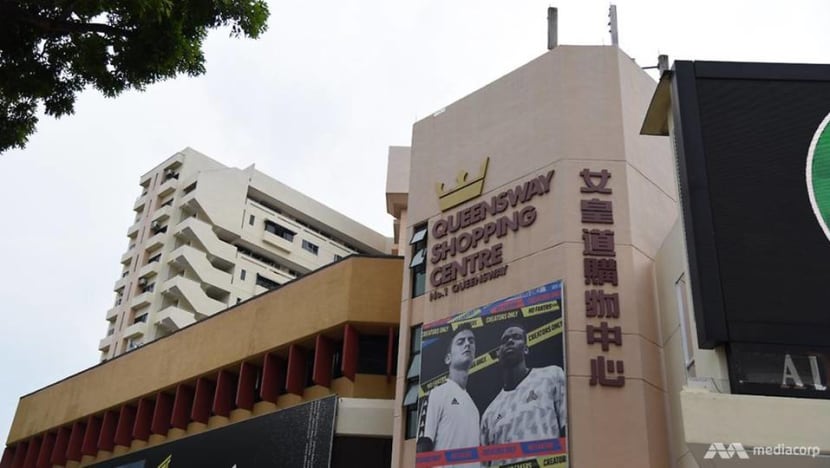
Queensway Shopping Centre (Photo: Darius Boey)
SINGAPORE: When the school bell rang, there was one place that then 13-year-old Wang Yiming looked forward to going, and it was not home. It was Queensway Shopping Centre.
Just a short five-minute bus ride away from her old River Valley High School campus at Malan Road, the octagonal mall was the ultimate hangout spot for the lower secondary school student and her friends.
More than a decade later, the 24-year-old freelance creative said she still reminisces about the icon of Queenstown, where she spent her formative years.
“I even got my first floorball stick there,” she recalled wistfully.
Days that were not spent hunting for good deals were instead spent huddled over fries with her friends at McDonald’s, laughing and sharing the latest gossip, among other things.
With so many fond memories from her youth, she was aghast when she recently read reports about an attempt to put up the shopping centre — one of Singapore’s oldest existing malls — for an en-bloc sale.
While Ms Wang acknowledged the Republic’s spatial limitations, she questioned why symbols of the past could not be preserved.
“We’re always tearing down and discarding the old,” she lamented.
On social media, many also expressed disappointment at the news, even though the en bloc attempt is expected to run into strong opposition from commercial tenants as well as some of those living in the adjoining Queensway Tower, which is included in the proposed collective sale.
The dismay felt over the en bloc attempt of Queensway Shopping Centre, which was built in 1976, mirrored the reactions of some Singaporeans when they first learned that Golden Mile Complex was put up for collective sale in late October last year — even though the building could be conserved, many felt that it would lose its distinctively Thai character. So far, there have been no takers for the 46-year-old Brutalist building on Beach Road.
Despite fancier and bigger malls springing up all over the island, some of Singapore’s pioneer shopping centres built in the 1970s and early 1980s such as Queensway Shopping Centre and Golden Mile Complex have retained a special place in Singaporeans’ heart — even among younger generations who are drawn to their unique offerings and distinctive characters.
Their plight, along with en bloc sales of old residential properties, seemed to have renewed interest among people in buildings constructed a few decades ago. Some questioned why these older structures have to make way.
“I’m not sure if looking old is any reason for (these buildings) not to exist,” said Mr Darren Soh, 43, a photographer who has been documenting architecture from Singapore’s early independence years for the last 10 years or so.
His works, which have been published in a book, have also been widely shared on social media. The latest is a photo essay titled Portrait Mode, which documented Pearl Bank Apartments over a period of five years, up to the time when residents had to vacate their units recently.
Chinatown’s landmark horseshoe-shaped building, which was built in 1976, was sold for S$728 million in February last year and is likely headed for demolition despite calls for it to be conserved.
Mr Soh said he was alarmed at the rate at which Singapore’s urban landscape was changing, and wanted to ensure there were visual records of these old places. He said:
The built landscape in Singapore is changing so rapidly that you probably wouldn’t recognise it from your childhood (days).
For a country that is about to celebrate its 54th National Day, he said there should be room “for us to look a bit more at our heritage and history, especially buildings built after independence”.
Furthermore, they are also a legacy of the Republic’s pioneer architects, said Singapore University of Technology and Design’s Associate Professor Yeo Kang Shua.
They represent “a certain phase of our architectural development”, and this was a period when the architects were experimenting with Modernist designs, he said.
As far as shopping complexes are concerned, the architecture and sustainable design professor said that some might be in favour of replacing an old mall with something contemporary offering a one-stop experience for shoppers. However, it would lack the same charm that certain older buildings had acquired, and the reputation they had developed.
Over the years, Queensway Shopping Centre became known for its sporting goods, for example. Others, such as Tanjong Katong Complex, Bras Basah Complex and Peninsula Shopping Centre, have also carved out a niche for themselves while keeping up with the times.
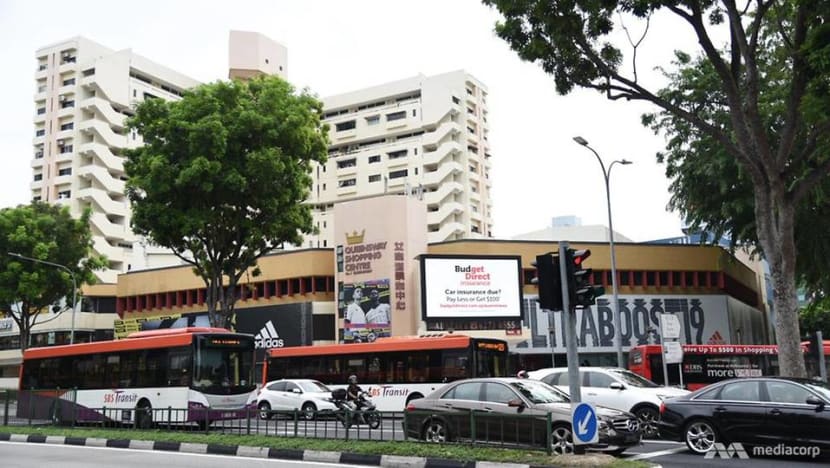
While they may no longer be doing rip-roaring business these days and face an uncertain future, these malls are symbols of resilience — holding their own despite the onslaught of new mega malls and e-commerce.
Many have developed a unique identity and loyal following, while reinventing themselves and drawing younger customers over the decades.
QUEENSWAY SHOPPING CENTRE
It was lunchtime on a weekday and there was barely any space to sit for a meal.
On the ground floor of the 100,000 square feet strata-titled mall, a line had formed along Janggut Laksa eatery as hungry visitors waited to tuck into a steaming bowl of the Katong variant of the local favourite.
Elsewhere, others took advantage of the lull in the workday to either get their badminton racquets restrung, pick up a new pair of leather shoes or get their clothes tailored.
Even though there was a bustling crowd within the retail section of the ageing development, tailor Roy Tik said this was nothing compared to its heyday.
The fashionably dressed 70-year-old, who had bits of thread on his fitting black turtleneck top, said the mall used to be so crowded that it was impossible to put a chair along the walkway.
“People were queuing up to pay (for their purchases),” said Mr Tik, who has been operating within the mall for more than two decades.
Mr Gurbachan Singh, 68, recalled that when he started working at Salam & Sons in 1987, going to the toilet was an ordeal as he had to push past people just to get there.
“I wouldn’t even have time to talk to you like I am (doing) now,” said the sporting goods shop’s manager, who added that he sometimes had to forgo lunch because of the number of customers he had to deal with.
Founded in 1976, the same year the mall opened, Salam & Sons was one of the mall’s pioneers in selling sports equipment and apparel. Back then, Queensway had yet to gain its reputation for being a sports mall. Instead, Mr Singh remembered there were a lot of shops selling jeans.
Mr Ken Lim, 57, also recalled seeing vegetable sellers and aquarium shops during his regular trips to the mall for Japanese classes around the late 1980s to early 1990s.
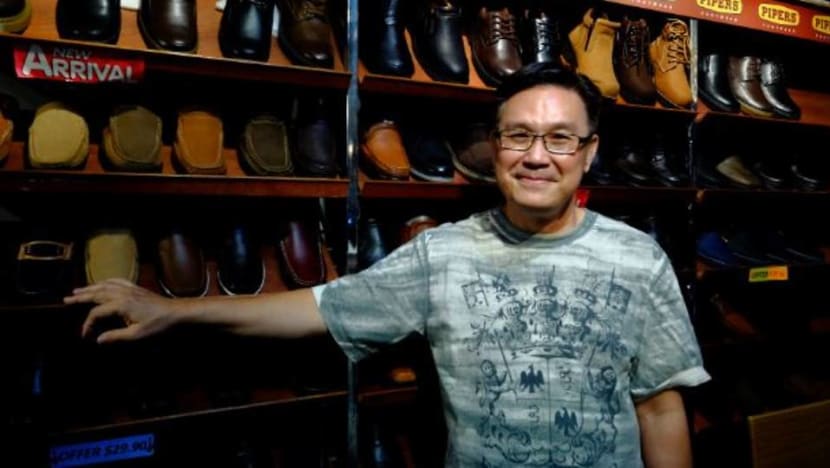
It was both eclectic and “very messy”, said Mr Lim.
The loyal customer became a shop owner there: He liked the place so much that in 1986, he set up his own shop there, the Rising Shoe Shop.
Mr Singh said that it was some time in the 80s that his shop’s business started picking up. People became more interested in sports, and competitors started coming in. But he did not mind.
“Honestly, here we don’t compete with each other. No one was trying to undercut the other,” he said.
Mr Lim said this is part of the culture at the mall. “It’s like a neighbourhood; we are like family. Even when customers (first) come in, they become like (our) friends. Any subject you want to talk, can talk.”
Indeed, Ms Wang recalled having many interesting interactions with the shop owners who often acceded to her customisation requests when it came to her clothes. “There was a sense of familiarity. The shop owners were friendly and approachable and we could just connect,” she said.
As tastes and trends change, Mr Mohaiyaden Marecar, who runs the family-owned SS Sports shop with his father, said one needs to specialise in something in order for business to thrive.
For instance, apart from providing a retail space for all things badminton related, the 28-year-old and his father also repair badminton racquets.
Both Mr Lim and Mr Tik agreed that providing extra services is the only way for them to have an edge over the competition from e-commerce.
Product knowledge is key so that you can make the best recommendation for your customers, said Mr Lim. Mr Tik, meanwhile, said that he has been offering tailoring lessons.
Still, Mr Lim believed that Queensway Shopping Centre could perhaps benefit from some new blood.
While it would be hard for newcomers to compete with the well-entrenched sports shops, the relatively low rent would provide the perfect opportunity for them to try out new business concepts, he said.
TANJONG KATONG COMPLEX
Surrounded by tall, sleek glass buildings, Tanjong Katong Complex stands out with its heavy concrete facade.
While it is commonly known as a place that serves the Malay community, particularly during the Hari Raya festive season, there is another aspect of its history that younger Singaporeans may be less aware of.
Located at the intersection of Sims Avenue and Tanjong Katong Road, the 204,514 square feet mall was opened in 1983 with much fanfare as it was the Housing and Development Board’s (HDB) first air-conditioned shopping complex.
At the time, the anchor tenant, Singapore’s first 24-hour Japanese supermarket Yokoso, got so popular that it became synonymous with the strictly-retail mall.
Currently, there are no casual eateries to be found among the 128 retail shops on any of its four floors. The only place where food is served is a Chinese restaurant on the top floor.
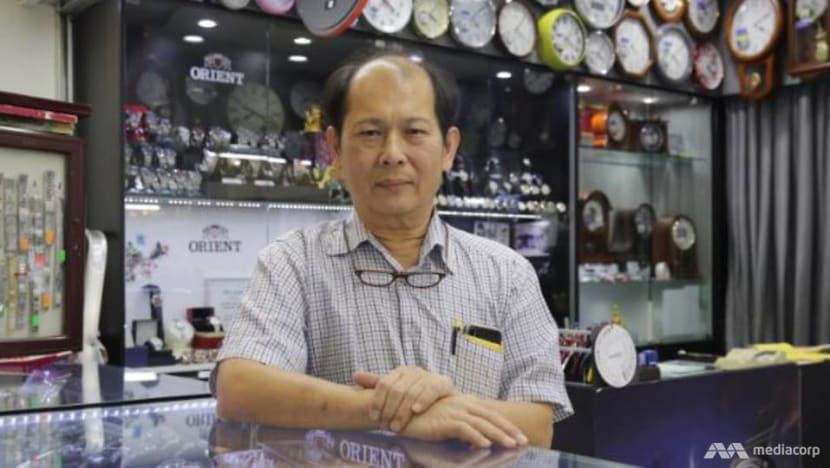
While Yokoso has since been replaced by the Giant supermarket, the building still retains the “Yokoso” nickname, said the 57-year-old.
Mr Lee has been working at the Dragon Corner optical and watch shop from the day the mall opened. The place used to house many Chinese merchants who had resettled from various kampungs, he said.
It was only when the old Geylang Serai market closed around 2006 for renovation that Mr Lee started noticing the appearance of more shops selling traditional Malay costumes, such as baju kurung and baju Melayu.
Mr Lee, who has since taken over the running of the business from his father, believed that these shops might have been drawn by the relatively lower and affordable takeover fees offered by the Chinese merchants.
The area surrounding Tanjong Katong Complex used to be a kampung for the Malays, said Mr Abdul Wahab Abdullah, who is touted to be Singapore’s sole songkok maker.
The 59-year-old, who has been selling the handmade traditional cap for Malay men after he was taught by his father, moved into the complex in 2004.
The hours may be long, but he takes pride in being able to customise the caps according to his customers’ needs — something they would not be able to do if they bought ready-made ones from the bazaars.
Depending on the complexity of the design, it takes him no more than two hours to put together a songkok. This speed is essential to meet the rise in demand for his craftsmanship in the lead-up to the Hari Raya celebrations.
Shortly after we spoke with Mr Abdul Wahab, a young man approached the craftsman with an infant in tow.
Mr Mohammad Hafiz, 32, said he wanted a songkok for his eight-month-old son. None of the off-the-rack caps were suitable for his toddler and he was told that only Mr Abdul Wahab could make one that fit, said the special needs teacher.
While business is good during Hari Raya period, Mr Abdul Wahab said he worries about making ends meet for the remaining 11 months of the year.
This is a concern shared by Mr Samsul Mabi, the 75-year-old owner of Elmaya House of Fashion.
Mr Samsul said that a majority of his customers are older Malay women, and that it is a challenge to attract younger women to his shop to buy baju kurung.
Another worry for the shopkeepers is the impending expiry of the mall’s lease in 2022.
The mall’s uncertain future has left several shopkeepers in two minds about making any upgrades or other drastic changes, said Mr Lee.
The building is currently managed by the Singapore Land Authority (SLA). In response to queries, an SLA spokesperson said that enhancement works were completed in 2015, including the replacement of lifts and escalators, toilet upgrading, façade painting and new flooring.
The spokesperson added that future plans for the site “are being studied with agencies and will be announced when ready”.
BRAS BASAH COMPLEX
Located within the arts and heritage district in Singapore's civic centre, the four-storey Bras Basah Complex greets customers with a sign declaring itself as “the centre of books and arts”.
Indeed, since its opening in 1980, Bras Basah Complex has established itself as a go-to place for book and art lovers.
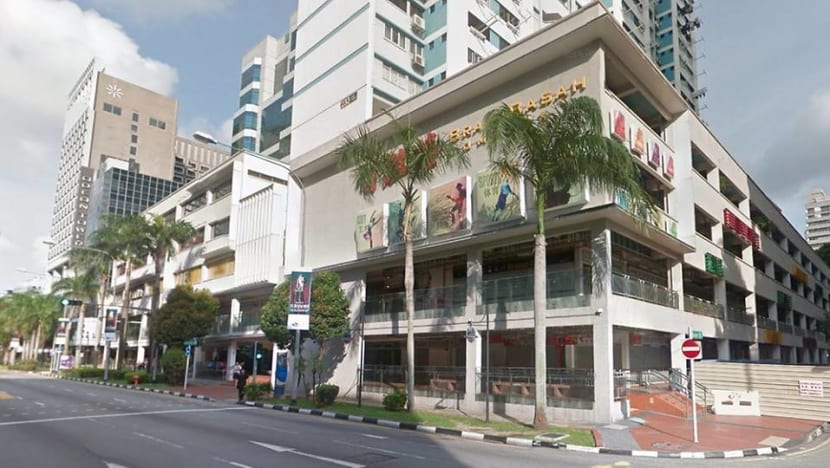
Amid the changing urban landscape and as printed books decline in popularity, several stores there have withstood the test of time, continuing their business ever since the complex’s inception.
One of these “old school” bookstores is Book Point, which sells a wide selection from fiction and non-fiction, to educational, business and reference books.
With a long history of over 50 years, the bookstore had first relocated from Bras Basah Road to set up shop in the complex, said owner Jawahar Ali, who inherited the business from his father.
Mr Ali, 55, noted that the area’s history as a book hub pre-dates the complex’s opening. “Bras Basah Road was well-known for book and art lovers. Shops (catering to these customers) lined the road,” he recalled.
Back then, the presence of many schools in the area — such as the Convent of the Holy Infant Jesus, St Joseph's Institution, Raffles Institution — helped Bras Basah establish its niche in books.
“In the past, schools did not have in-campus bookstores. Schools would give the students booklists, for them to buy outside,” said Mr Ali.
So if you wanted to buy books, you would come here. In the 1980s and 1990s, commerce here was full of life.
Even as times changed and people’s interests shifted, Bras Basah Complex has managed to retain its niche appeal.
But this has been no easy feat, said 67-year-old Tan Lay Hui, who runs bookstore Music Book Room.
“It’s a different generation, books are dying. We have no way to stop that, but the thing that we can do is to adapt and adjust,” said Mdm Tan in Mandarin.
Music Book Room is also a pioneer at Bras Basah Complex, occupying the same unit for the past three decades. At the beginning, the store used to sell a wide variety of magazines and books.
But “in order to survive and stand out from others”, the store shifted its focus to sell books related to music.
Similarly, Book Point had to adapt to changing customers’ preference, said Mr Ali.
Apart from shrinking its shop size, the store started to specialise in rare books in the 2000s, after schools opened their own bookstores and chains such as Popular established a foothold in the business.
“So for people who couldn’t find the books they wanted at regular bookstores, they had to come to Bras Basah Complex to find them,” said Mr Ali.
The reason why bookstores at the complex continue to thrive is also due to the loyalty of old customers. “They’re the ones that keep us going,” said Mr Ali.
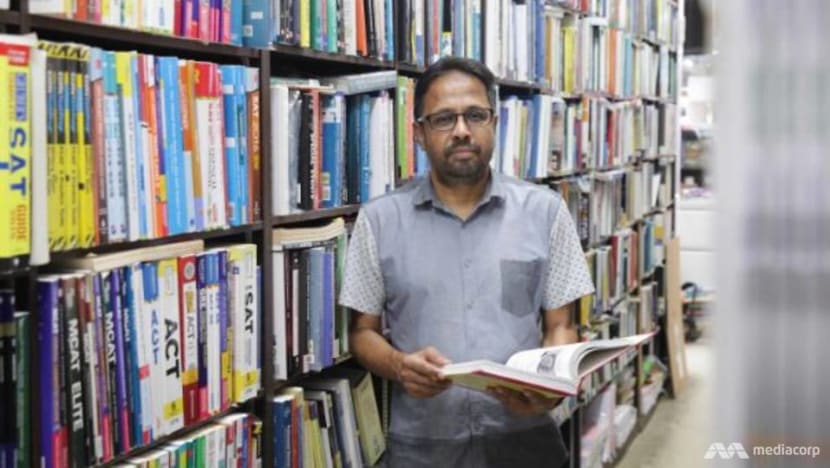
One of Book Point’s old-time customers is author Robert Yeo, who first patronised the original bookstore several decades ago at Bras Basah Road. He now visits the store at least once a month.
“I come here all the time because there are some of the best books here. Some of them are old books, first editions, ones you can’t find anywhere else,” said Mr Yeo, 79.
The complex is also a hotspot for younger customers such as architecture student Rahmat Khairudin, who describes it as “a creativity and resource hub for students”.
“Bras Basah Complex is irreplaceable and there’s really no such other place like this,” said the 27-year-old. “It relates to a community interested in the arts, and generations of students and family members come here for the same things.”
Apart from bookstores, Bras Basah Complex also hosts a growing number of art galleries and speciality shops.
At antique store Nanya, Mr Kok Seng Whatt collects and sells old coins and banknotes, while offering artwork mounting and framing services. The store has been there since the complex’s opening.
In the past, there were many Chinese bookstores here. They attracted the Chinese-educated here, and those interested in history were naturally drawn over to our shop,” said Mr Kok, 71, in Mandarin.
Despite the challenges faced by brick-and-mortar shops in Singapore’s cutthroat retail scene, the complex manages to retain a steady pool of customers due to the focus on arts, noted Mr Kok, who is also a committee member of the Bras Basah Complex Merchants’ Association. He said:
People are more open-minded and liberal now, (they) like these artworks and cultural artifacts. It’s their hobby and this helps us retain a loyal stable customer base.
PENINSULA SHOPPING CENTRE
Located near City Hall MRT, Peninsula Shopping Centre — whose facade has been largely untouched since its opening in 1974 — may stick out like a sore thumb amid swanky modern malls in the same area such as Capitol Piazza, Raffles City and the newly-refurbished Funan Mall.
But to some, it is a reflection of its resilience and ability to stay relevant to customers’ ever-changing needs.
One of Singapore’s first fully air-conditioned malls, it has evolved from being home to a mix of local retail shops to housing mainly music-related stores and services.
The shift started in the 2000s, said a spokeswoman from YTC Management which runs the mall.
Currently, the whole basement level is filled with about 10 shops offering music equipment, repair services, and jamming studios.
“A lot of music stores have taken over occupancy of the units, so much so that the influence has also spread over to the neighbouring Excelsior mall,” the spokeswoman added.
The mall’s niche in music was largely anchored by the growth of homegrown brands such as Davis Guitar and Swee Lee, said banker Eric Teh who has been going to the mall for the past 30 years.
“Back in my university years, I used to be in a band, so we’d come here often to get our equipment. Since then it’s quite remarkable how I’ve seen the place changed,” said the 52-year-old music lover.
For Davis Guitar, it first started out with a small unit in the shopping centre in 1989, before expanding in size over the years. Now, Singaporean and overseas artists are part of its clientele.
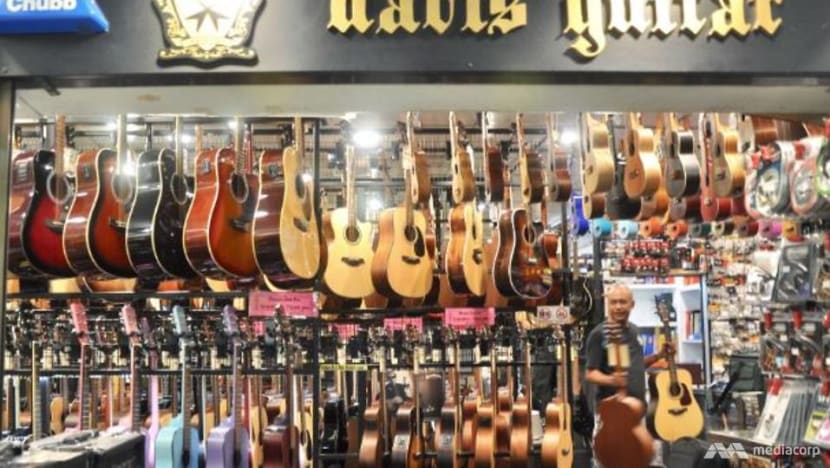
The mall’s steady customer pool has to do with the nature of the music business, said Ms Goh Yiling, 30, who grew up working at Davis Guitar. She added:
Despite the rise in online shopping, the retail experience for music products is very different. You have to come to the store, speak to people and have a relationship, and also try out the guitar first-hand yourself.
With its niche in music, the YTC spokesperson pointed out that the mall continues to see a growing number of related stores, and these in turn attract “more of the same crowd”.
For instance, in 2016, guitar repair store GworX chose to open its store in Peninsula Shopping Centre due to the mall’s established name as a “one-stop solution for guitars”.
“People who come here know what they are here for, so it was natural that we opened here. They buy their guitars downstairs, and when they need fixing they come to us,” said employee Danish Sadaya, 23.
Similarly, Mr Alagiry Alagirisamy set up his vinyl shop For The Record in the mall eight years ago due to its niche in music, and the nearby Adelphi mall that had shops selling hi-fi stereo systems.

“It was a hobby of mine to collect vinyls for over 40 years. Then there was this vinyl revival, so I opened here since it’s near numerous music stores as well,” said the 69-year-old.
With the music stores drawing a good crowd, other retailers in the mall have also adapted their business to capture a slice of the pie.
Initially only dealing in sports goods, Jet Win Sports Company started to sell tee-shirts bearing images of various music bands a few years ago.
“It was a sort of business strategy, because we could see what kind of people were coming in and we needed to stay relevant,” said owner Khoo Chuan, 65.















